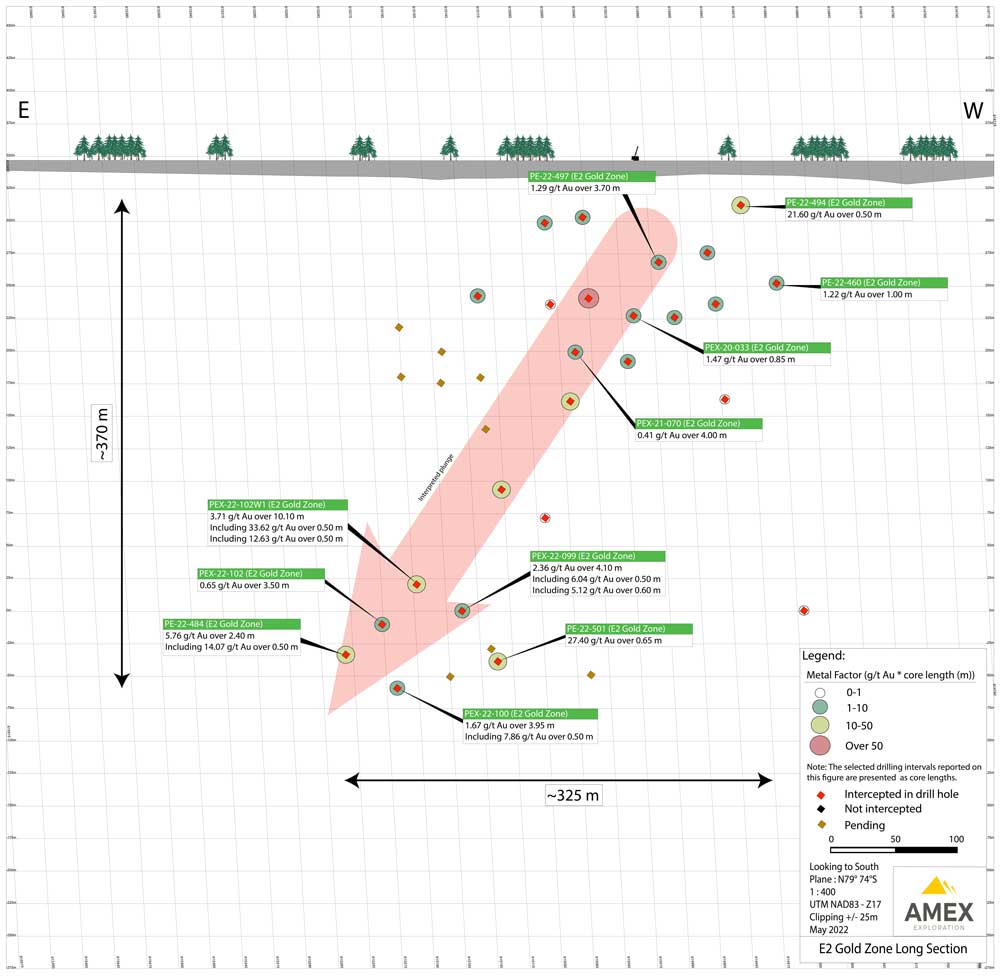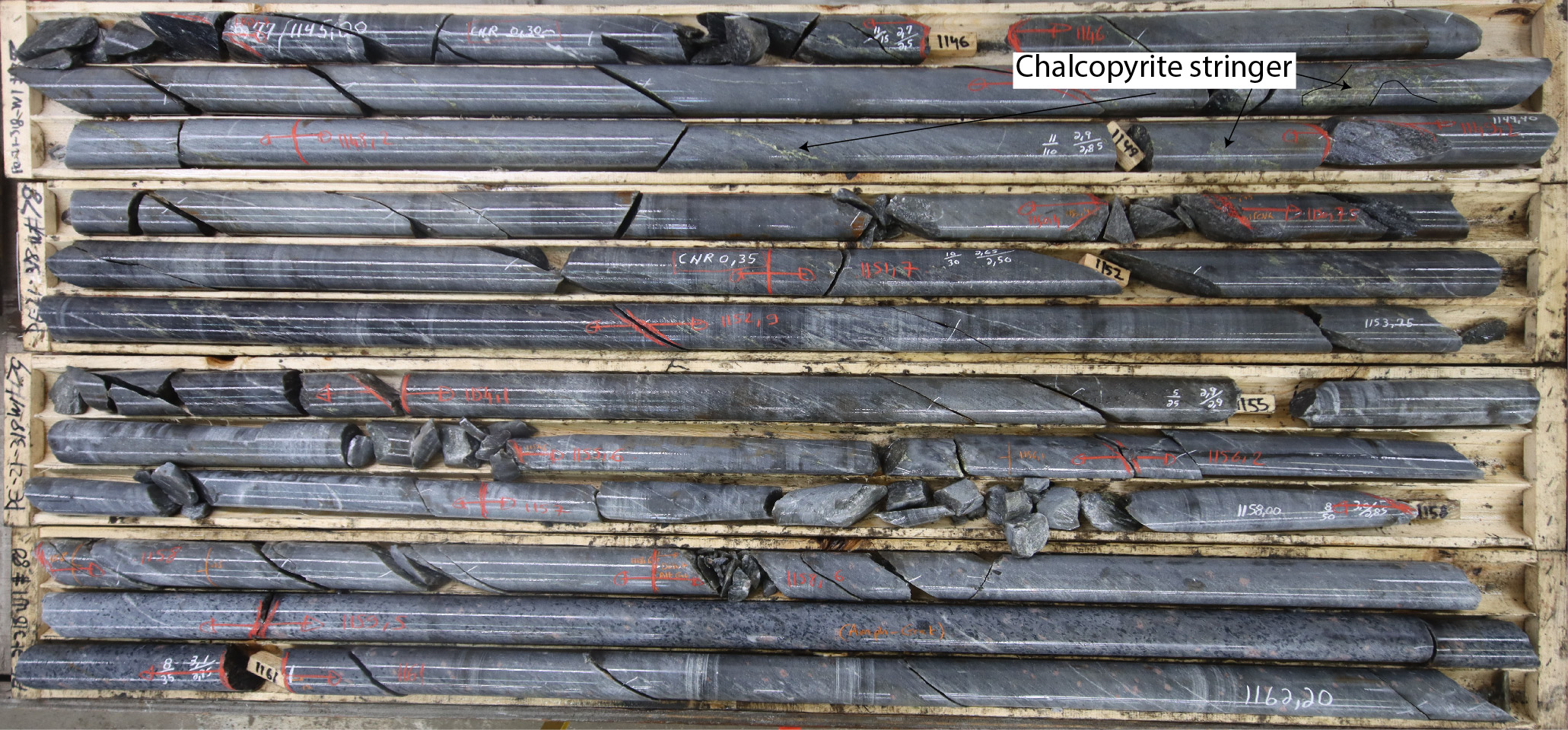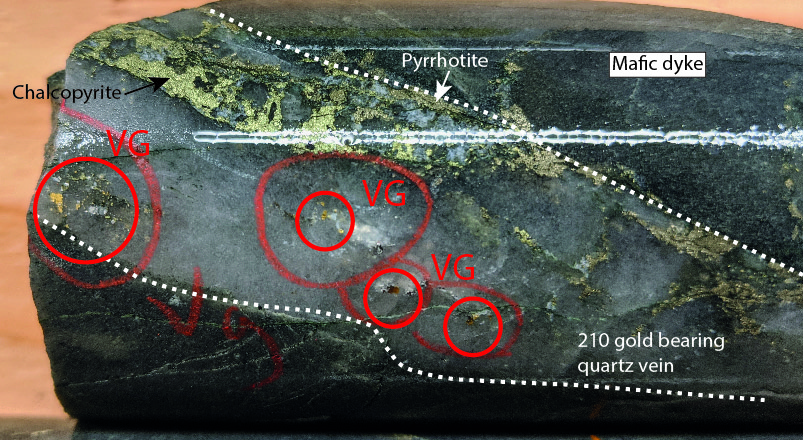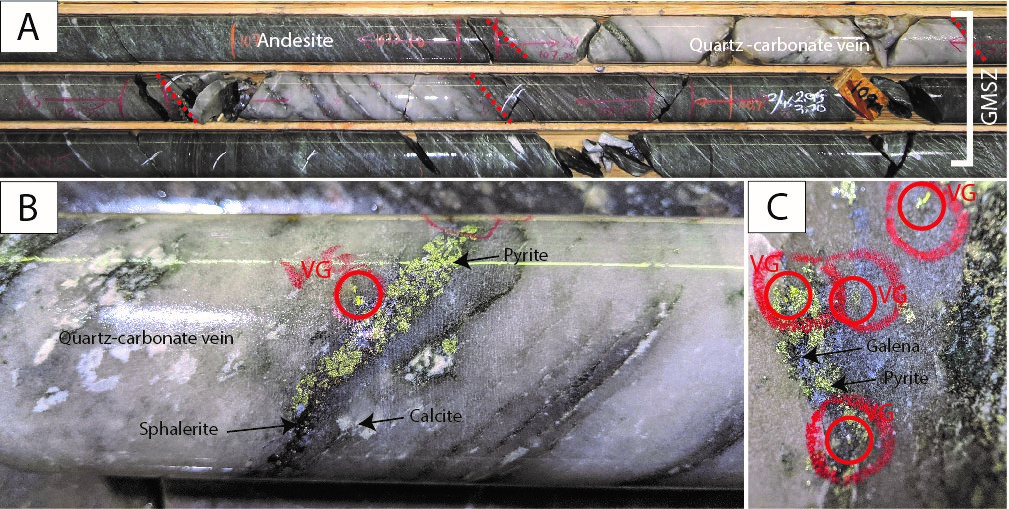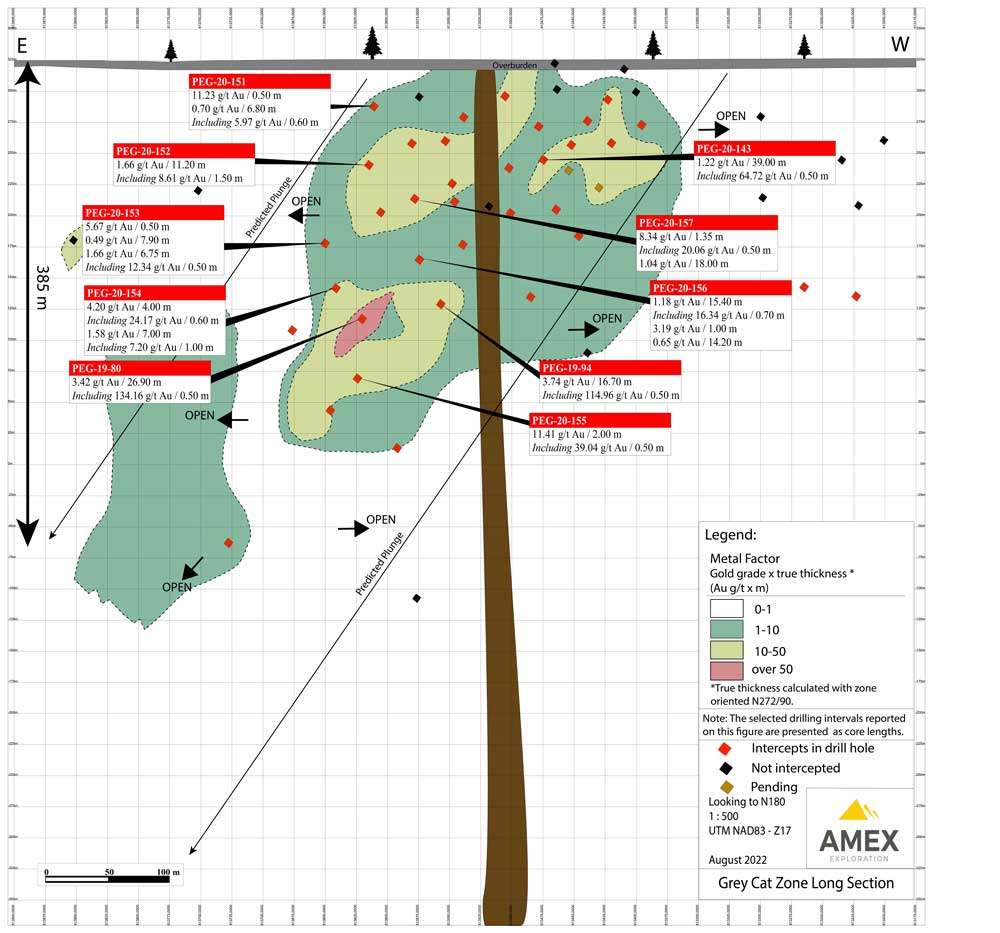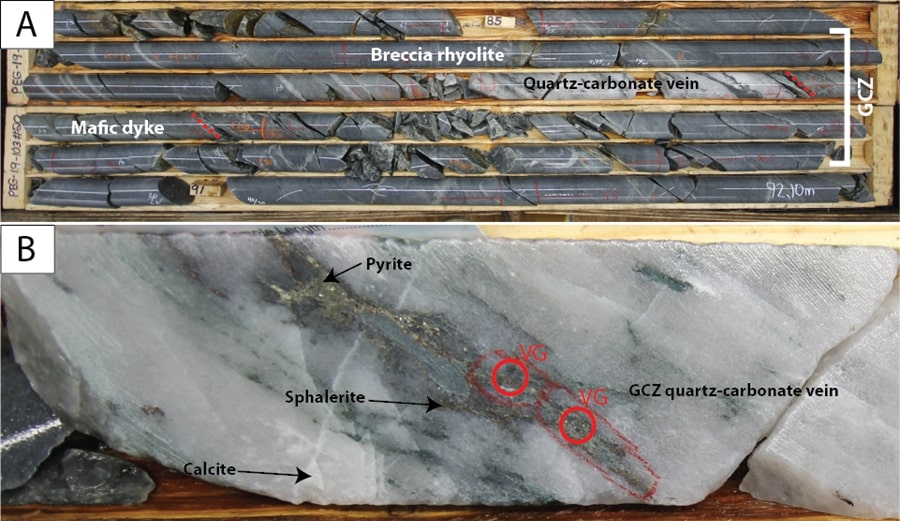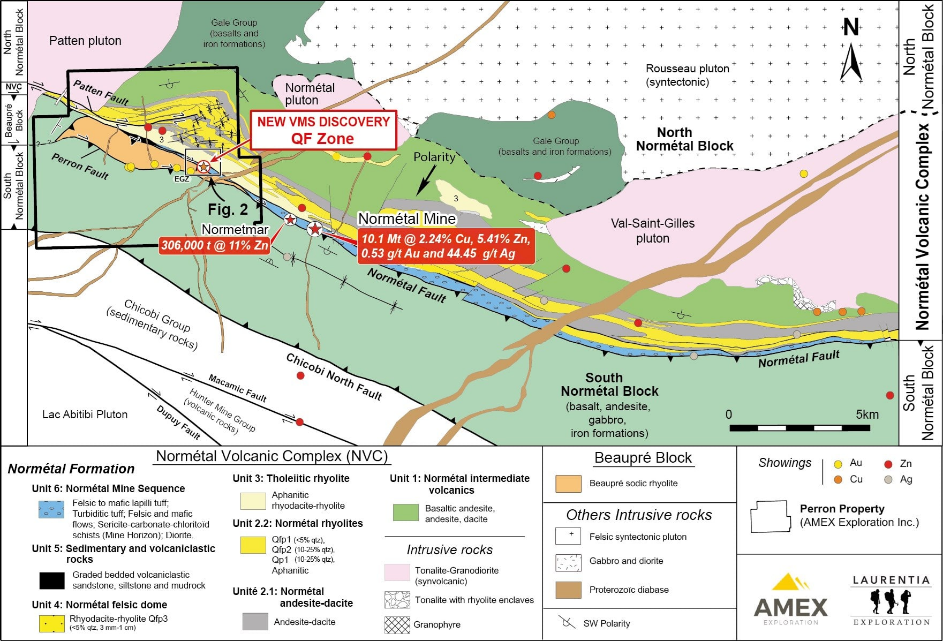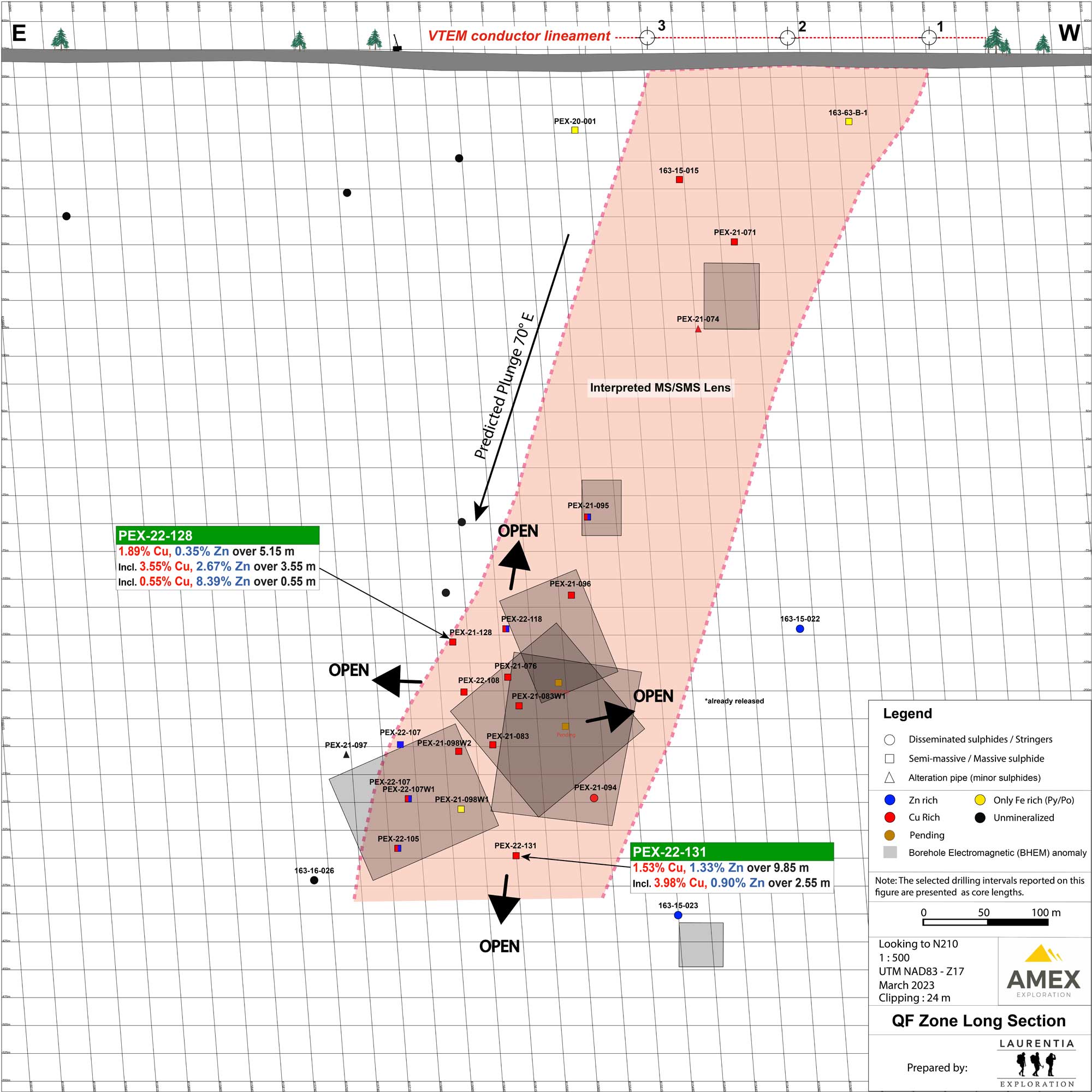| Geological Theory on Perron Project PDF |
The Perron gold property is located 8 km to the Northwest of the village of Normétal, and approximately 110 km North of the town of Rouyn-Noranda in the Abitibi region of Quebec. The Perron gold property is fully road accessible year-round by government-maintained highway and forestry roads and is proximal to power and water services. In addition, the project is in close proximity to a number of major gold producers milling operations.
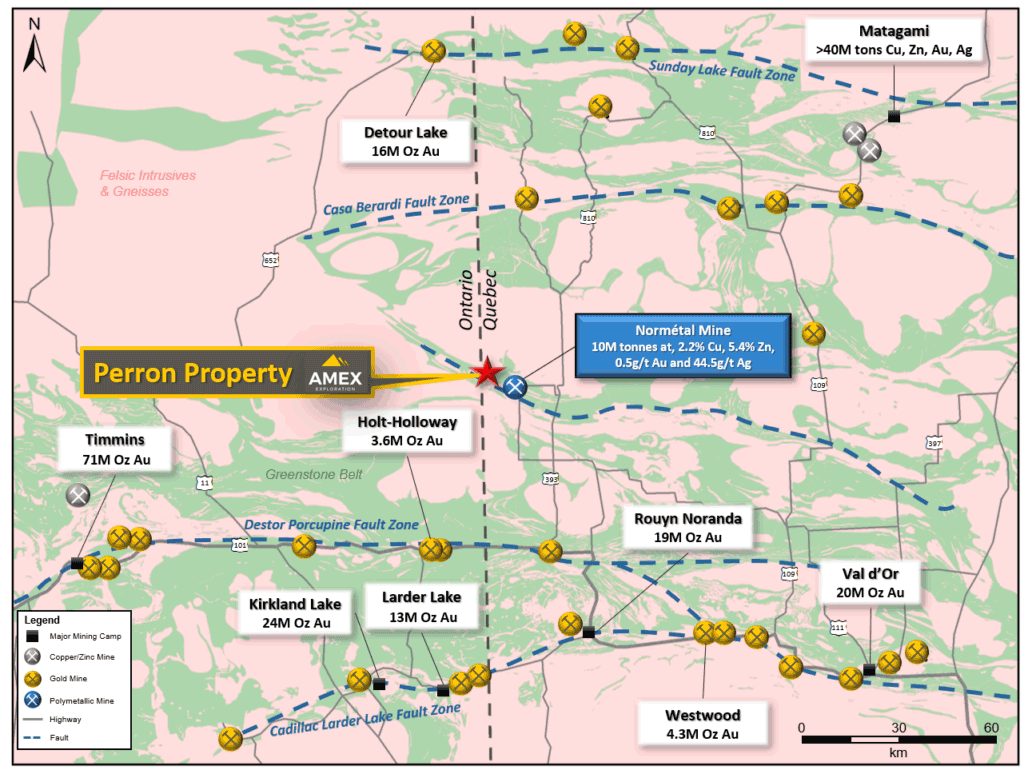 Geological mal of the Western Abitibi belt with the locations of major gold and base metal mines and Perron property.
Geological mal of the Western Abitibi belt with the locations of major gold and base metal mines and Perron property.
The property consists of 117 adjacent claims covering a total area of 4,560 hectares and is 100%-owned by Amex Exploration. The property is located in the Neoarchean Burntbush-Normétal volcanic belt of the Superior province. This belt includes different facies ranging from basalt through andesite to rhyolite and their subvolcanic equivalents and bounded to the south by the late Chicobi sedimentary rocks. These rocks are favourable for volcanic massive sulfides and gold development. The area is crossed by the regional NW-SE trending Normétal and Perron faults. The Normétal fault is coincident with a stratigraphic horizon known to host massive sulphide deposits such as the nearby past-producing high-grade polymetallic (Cu-Zn-Au-Ag) Normétal mine and the Zn Normetmar satellite deposit and also related to several epigenetic gold showings. The Perron fault is located about 500 to 1,000 m South of the Normétal Fault and is related to several epigenetic gold deposits and showings. These showings are hosted in sodic rhyolite of the Beaupré block including the Eastern Gold Zone (EGZ) following to the west by Grey Cat Zone and Gratien Gold Zone.
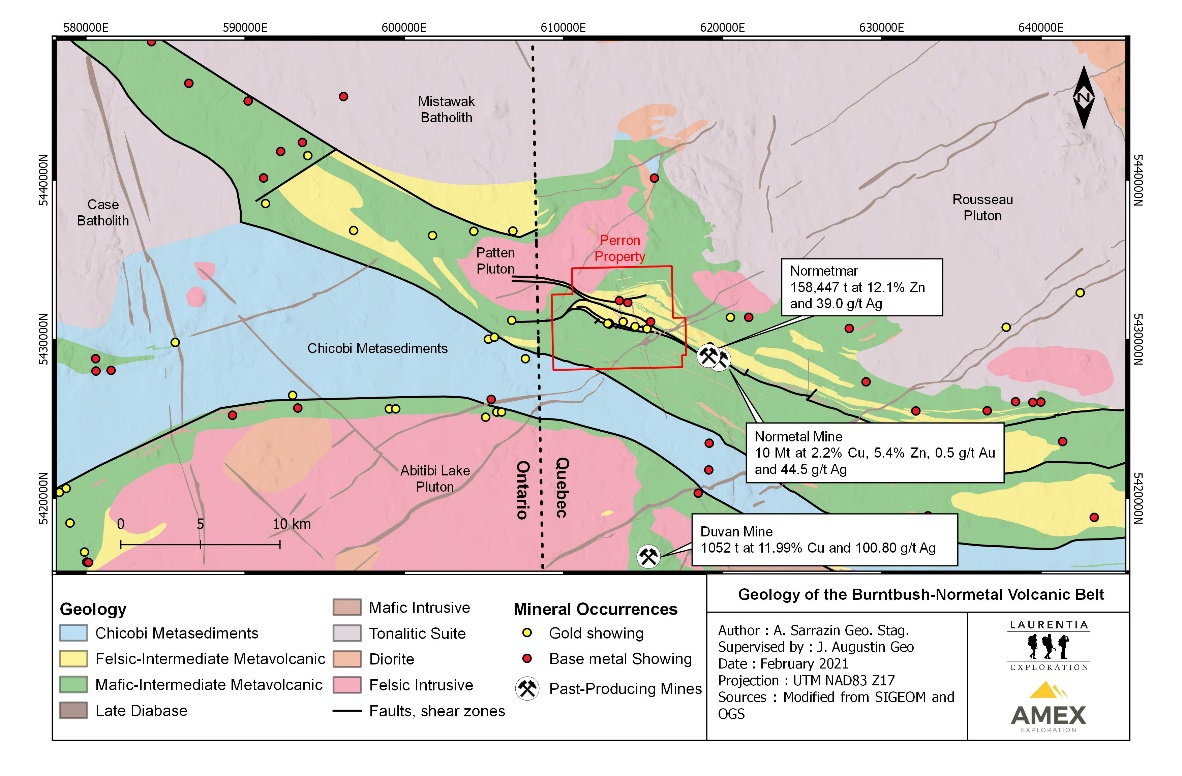 Simplified geology (SIGEOM) of the Burntbush-Normétal volcanic belt.
Simplified geology (SIGEOM) of the Burntbush-Normétal volcanic belt.
The Perron property was originally explored for base metals from 1994 to 1996 by Falconbridge Limited. Amex, formerly known as Minières Coleraine, was granted an option to acquire the property in 1996. The option agreement terms have long-since been fulfilled and Amex now owns 100% of the Project.
Since the acquisition of Perron, Amex has made a number of gold and base metal discoveries, namely the Eastern Gold Zone (which includes the High Grade Zone (HGZ), the Denise Zone (DZ) and other gold zones), the Gratien Gold Zone, the Central Polymetallic Zone, the Grey Cat Zone as well as several compelling regional drill results that warrant additional follow-up.
Recent regional exploration programs led to many important new discoveries: the Team Zone, 210 Gold Zone, Alizée Gold Zone, the E2 Gold Zone, Upper High Grade Zone, E3 Gold Zone, and a new copper rich VMS discovery named the QF Zone.
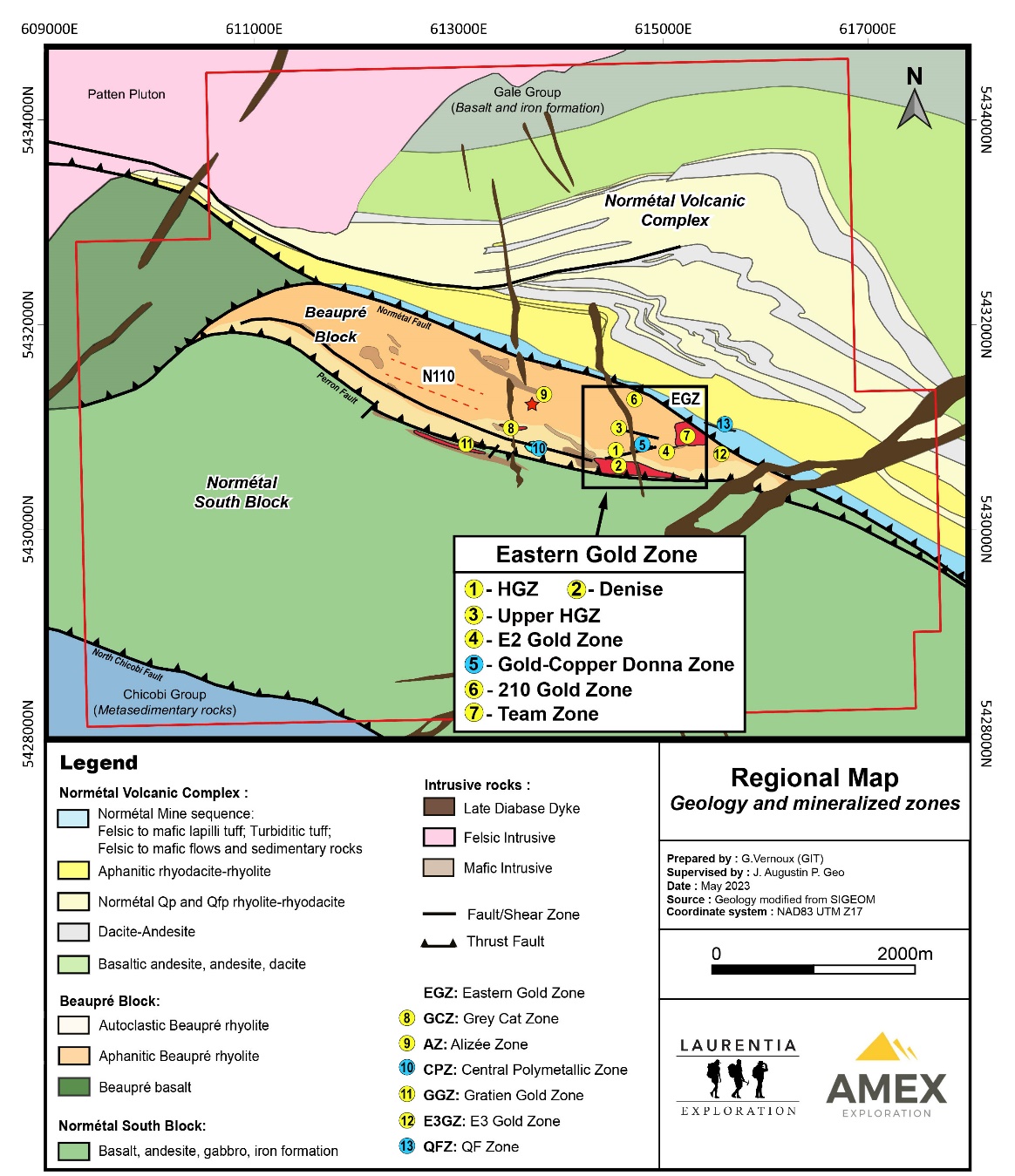 Geological map of the Perron Project, showing each of the significant mineralized zones.
Geological map of the Perron Project, showing each of the significant mineralized zones.
Eastern Gold Zone
The Eastern Gold Zone (“EGZ”) was discovered in December of 2017 during a regional exploration drilling campaign. The discovery hole, PE-17-03, identified two zones of near-surface mineralization, now called the High Grade Zone and the Denise Zone, which returned values including 12.22 g/t Au over 4.66 m of core length and 0.81 g/t Au over 76.50 m of core length, respectively. Follow-up drilling in 2018 in drill hole PE-18-17 intersected values including 269.23 g/t Au over 1.35 min core length and 0.74 g/t Au over 20.75 m (core length) in the High Grade Zone and Denise Zone, respectively. Following this, a targeted exploration drill program began in Q1 of 2019 totalling approximately 3,000 m targeting the HGZ, from which assays have returned grades including 393.33 g/t over 1.70 m (core length) in PE-19-22, 39.58 g/t Au over 0.75 m (core length) in PE-19-23, and 214.71 g/t Au over 0.65 m (core length) in PE-19-24.
The 2020-2022 drill program, Amex further defined and expanded the Denise Zone and identified exceptional high-grade gold continuity in the High-Grade Gold Zone (HGZ). To date, Amex has hit very high-grade and often visible gold in multiple zones across the project forming a corridor of gold mineralization extending over 4 km between Eastern Denise to Western Gratien Gold Zone.
The carefully planned 2022 regional exploration program led to important new discoveries:
- the Team Zone
- the E2 Gold Zone
- the Donna Gold-Copper Zone
- the Upper HGZ
- the 210 Gold Zone
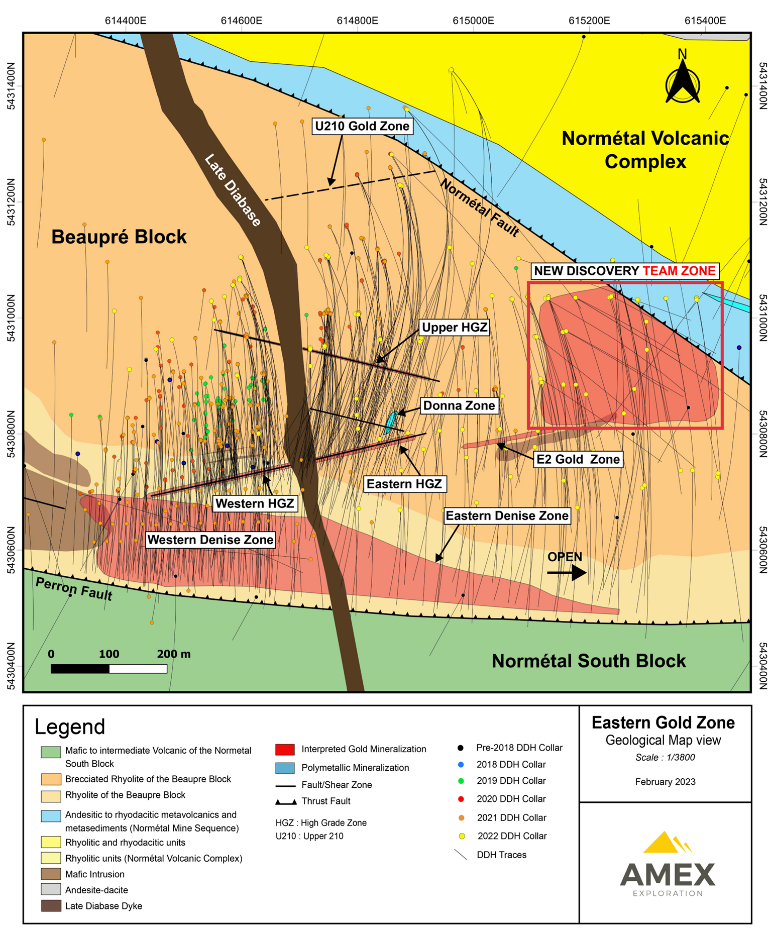 Geological map of the Eastern Gold Zone area, showing the locations of all identified zones.
Geological map of the Eastern Gold Zone area, showing the locations of all identified zones.
- Define the Team Zone from surface to ~450 vertical metres at 50 m centres;
- Expand the Gratien Gold Zone to the West and to depth;
- Expand on and infill the HGZ and Denise zone as required;
- Test the N110 Gold Corridor for HGZ-type ore shoots;
- Drill to expand the VMS mineralization at the QF Zone as well as test the newly identified eastern VMS target;
- Expand upon the surface geochemistry program of 2022 using the ionic leach method, which showed many promising anomalies across the project;
- Launch a resource estimate;
- Continued environmental baseline studies, expanding on work completed by BBA in 2022;
- Economic & engineering studies, following the resource estimate; and
- Expand our executive team with a technical committee of Development/Mining-focused professionals.
High Grade Zone
The High Grade Zone is composed of quartz vein system hosted along the contact of a regionally extensive rhyolite package and a narrow (~1-5 m) mafic intrusion. The quartz vein(s) can occur at the upper and/or lower contact of the intrusion. Visible gold mineralization occurs most often in association with sphalerite but also as free gold within quartz or at the margins of pyrite grains. The zone strikes approximately at N265 with a dip at -85° with a slight plunge to the East at 70 to 80 degrees from vertical, in agreement with the local stretching lineation. Mineralization identified to date appears to share similarities with Archean orogenic vein-hosted gold deposits found elsewhere in the Abitibi Greenstone Belt and around the world. The zone has been intersected in the same longitudinal section over a vertical distance of approximately 1,260 m over varying spaces.
Amex demonstrated the exceptional high-grade gold continuity of HGZ down to a vertical depth of 1.26 km. The Company also reported the highest-grade individual assay at Perron of 929.24 g/t Au over 0.50 m at a vertical depth of 290 m in hole PE-21-344.
Highlights from 2023 drilling of the Deeper High Grade Zone (HGZ East) include:
- PE-22-535 returned 75.81 g/t Au over 4.85 m at a vertical depth of ~750 m
- PE-22-524W5returned 7.40 g/t Au over 14.80 m at a vertical depth of ~1,200 m
Highlights from 2022 drilling of the Deeper High Grade Zone include:
- PE-21-404W2 returned 35.89 g/t Au over 6.75 m at a vertical depth of ~940 m
- PE-21-386W1 returned 102.07 g/t Au over 6.10 m at a vertical depth of ~870 m
- PE-21-318 returned 29.62 g/t Au over 8.40 m at a vertical depth of ~ 1,120 m
- PE-21-287 returned 37.59 g/t Au over 6.20 m at a vertical depth of ~1,070 m
- PE-21-360 returned 17.01 g/t Au over 7.40 m at a vertical depth of 500 m
- PE-21-360W1 returned 10.21 g/t Au over 7.40 m at a vertical depth of 660 m
- PE-21-165W2 returned 4.46 g/t Au over 15.60 m at a vertical depth of 660 m
- PE-21-301W1 returned 10.25 g/t Au over 6.10 m at a vertical depth of 910 m
Highlights from the 2022 drilling of the Shallower High Grade Zone (Western HGZ) include:
- PE-21-366W1 returned 78.62 g/t Au over 5.90 m at a vertical depth of ~630 m
- PE-21-405 returned 43.74 g/t Au over6.80 m at a vertical depth of ~300 m
- PE-21-391 returned 84.02 g/t Au over 5.60 m at a vertical depth of ~170 m
- PE-21-409 returned 43.74 g/t Au over 6.90 m at a vertical depth of ~170 m
- PE-21-383W1 returned 76.61 g/t Au over 3.50 m at a vertical depth of ~480 m
- PE-21-392 returned 36.02 g/t Au over 6.55 m at a vertical depth of ~250 m
- PE-21-367 returned 21.75 g/t Au over 14.90 m at a vertical depth of ~190 m
- PE-21-371 returned 11.97 g/t Au over 6.95 m at a vertical depth of ~120 m
Note: the HGZ drill results presented above represent core length. True width is estimated to be 55-80% of the reported core length.
Longitudinal section of the High Grade Zone looking to the south, showing contoured metal factor (Au g/t * estimated true thickness).
True width is estimated to be 55-80% of the reported core length.

Photos of the HGZ mineralization-style (PE-19-22).
A) Quartz-carbonate shear veins of the HGZ.
B) Visible gold associated with sphalerite in a HGZ quartz-carbonate vein.
C) Visible gold (VG) associated with pyrite in a HGZ quartz-carbonate vein.
Denise Zone
The Denise Zone (DZ), located 50 to 100 m south and sub-parallel to HGZ, consists of disseminated and quartz vein-hosted gold mineralization hosted within a regionally extensive rhyolite package that lies north of an andesite. Gold mineralization is associated with intense sericite alteration and sulfides including pyrite & sphalerite. Denise is a bulk tonnage target. Exploration plans for 2023 was for 10,500 m of drilling aimed at both definition and expansion. A further 4,200 m was dedicated to a target to the western Denise at depth.
To date, the Company intersected at least 750 vertical metres of gold mineralization starting from surface across a strike of more than 1 kilometre. The Denise Zone surpassed expectations showing large zones of broad near-surface gold mineralization and continuity. The geology indicates probability to expand to the east near surface.
Highlights from Western Denise include:
- PE-21-422 intersected 1.89 g/t Au over 65.00 m, including 197.35 g/t Au over 0.50 m at a vertical of depth of ~345-390 m
- PE-21-392 intersected 1.82 g/t Au over 58.50 m, including 177.65 g/t Au over 0.50 m at a vertical of depth of ~350-400 m
- PE-20-188 intersected 1.09 g/t Au over 189.40 m, including 1.94 g/t Au over 24.50 m at a vertical of depth of ~300 m
- PE-20-54EXT intersected 2.12 g/t Au over 50.00 m, including 4.90 g/t Au over 15.10 m at a vertical of depth of ~130 m
- PE-20-181 intersected 1.39 g/t Au over 115.60 m, including 51.03 g/t Au over 2.50 m at a vertical of depth of ~260 m
Highlights from Eastern Denise include:
- PE-22-510 intersected 11.57 g/t Au over 30.90 m, including 601.47 g/t Au over 0.50 m at a vertical of depth of ~510 m
- PE-22-468 intersected 0.88 g/t Au over 41.30 m, including 1.50 g/t Au over 14.90 m at a vertical of depth of ~230 m
Note: the Denise drill results presented above represent core length. True width is estimated to be 60-90% of the reported core length.
 Longitudinal section of the Denise Zone looking to the south. Assay results are presented in core length (m). True width is approximately 60-90% of reported intercepts. Metal factor is defined as gold grade multiplied by estimated true thickness.
Longitudinal section of the Denise Zone looking to the south. Assay results are presented in core length (m). True width is approximately 60-90% of reported intercepts. Metal factor is defined as gold grade multiplied by estimated true thickness.
 Photos of the Denise Zone mineralization-style (PE-19-45 and PE-20-192).
Photos of the Denise Zone mineralization-style (PE-19-45 and PE-20-192).
A) DZ defined by highly sericitised brecciated rhyolite and disseminated sulfides.
B) Visible gold (VG) in a DZ quartz-carbonate vein.
C) VG associated with sphalerite in a boudinated quartz-carbonate vein.
Team Zone
Discovered in Q4 of 2022, ongoing drilling has resulted in this zone being a significant component of the overall mineralized system at Perron. The Team Zone occurs ~600 m to the northeast of the High Grade Zone (HGZ) and ~300 m northeast of the E2 Gold Zone. The Team Zone is currently outlined over 350 m x 200 m laterally and from surface to a depth of approximately 400 m. Mineralization style is defined by centimetric shear to tension gold bearing quartz-sulfides veins/veinlets. Sphalerite, pyrite and traces of chalcopyrite and molybdenite are associated together with a significant amounts of visible native gold grains
Highlights from 2023 drilling of the Team Zone:
- PE-23-633 intersected 26.88 g/t Au over 6.40 m, including 325.39 g/t Au over 0.50 m, at a vertical depth of ~205 m
- PE-23-634 intersected 12.71 g/t Au over 9.00 m, including 78.38 g/t Au over 1.40 m, at a vertical depth of approximately 35 m, and 4.29 g/t Au over 5.10 m at a vertical depth of ~195 m
- PE-23-641 intersected 4.67 g/t Au over 7.10 m, including 60.91 g/t Au over 0.50 m, at a vertical depth of approximately 250 m, and 20.39 g/t Au over 2.50 m at a vertical depth of ~325 m
- PE-23-627 intersected 1.70 g/t Au over 68.00 m, including 7.89 g/t Au over 9.70 m, at a vertical depth between 135 and 195 m
- PE-22-588 intersected 8.68 g/t Au over 4.00 m, including 19.89 g/t Au over 1.50 m, at a vertical depth of ~140 m
Note: the Team Zone drill results presented above represent core length. True width is currently unknown.
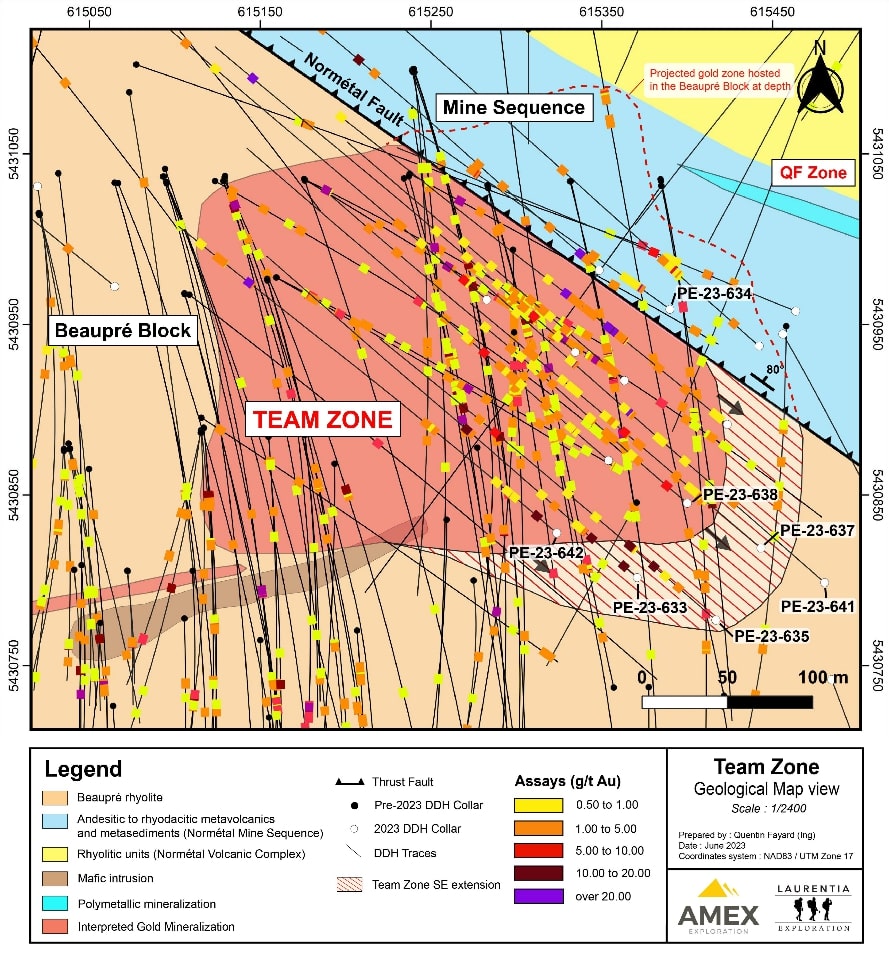 Geological map of Team Zone area of the Perron property, showing gold mineralization greater than 0.50 g/t Au.
Geological map of Team Zone area of the Perron property, showing gold mineralization greater than 0.50 g/t Au.
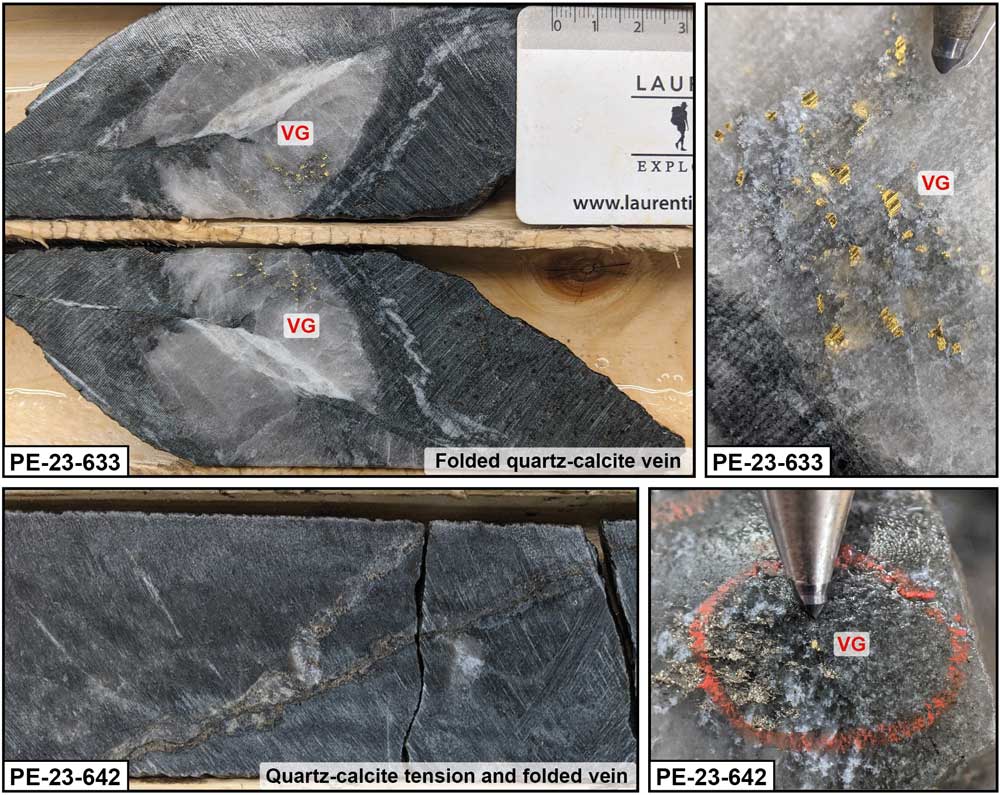
Photos of Team Zone mineralization intersected in drillholes PE-23-633 and PE-23-642. Abbreviation: VG - Visible Gold.
E2 Gold Zone
The E2 Gold zone ("E2") represents one of the most significant new discoveries on the Perron Project since the discovery of the HGZ in 2018. The E2 zone was discovered by stepping out to the East along the same structure that hosts the bonanza mineralization of the HGZ.Mineralization identified to date is very similar to the HGZ, with a repetition of a mineralized hanging wall vein, a largely unmineralized narrow mafic sill, and a mineralized footwall vein. Sulfide minerals are also very similar, with sphalerite being the most common sulfide associated with gold mineralization, along with lesser pyrite. Visible gold has been identified in several drill holes. Of particular importance is the projected plunge of the mineralization. The E2 has now been expanded down to a vertical depth of 370 m and along strike for 325 m.
Highlights from E2 Gold Zone include:
- PEX-20-034 returned 5.58 g/t Au over 13.85 m including 136.02 g/t Au over 0.55 m at a vertical depth of ~100 m
- PEX-21-066 returned 4.54 g/t Au over 8.45 m at a vertical depth of ~170 m
- PEX-22-102W1 returned 3.71 g/t Au over 10.10 m including 33.62 g/t Au over 0.50 m at a vertical depth of ~320 m
Note: The drill intervals for the E2 are presented in core lengths, as its estimated true width is currently unknown.
Longitudinal section of the E2 Gold Zone looking to the south. Assay results are presented in core length (m). Metal factor is defined as gold grade multiplied by core length.
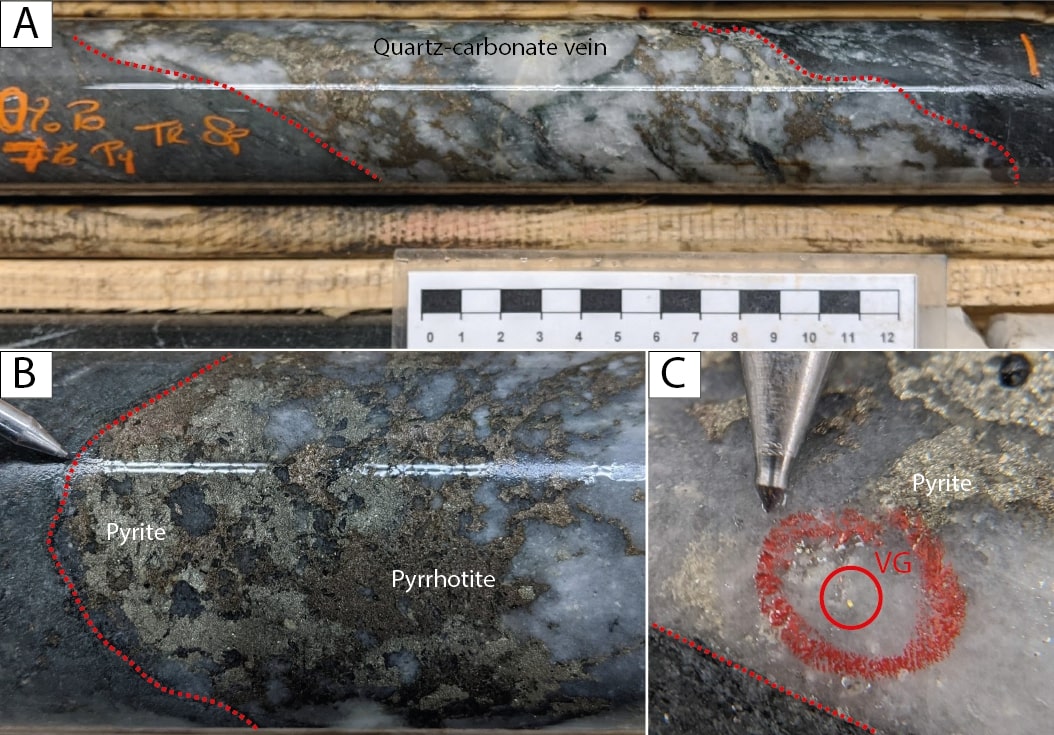
Photos of the E2 Gold Zone.
A) Gold bearing quartz-carbonate-sulfides shear vein.
B) Sulfides assemblage defined by pyrite and pyrrhotite in gold bearing quartz-carbonate vein.
C) Example of visible gold in the quartz-carbonate vein.
Upper High Grade Zone
The Upper High Grade Zone ("UHGZ") is situated approximately 200 m North of the HGZ Of interest is the orientation of the UHGZ, which trends to the West-Northwest, at an angle of approximately 30 degrees away from the orientation of the HGZ. The UHGZ is often hosted by or proximal to a swarm of narrow mafic sills/dikes, and mineralization is associated with quartz veining, pyrrhotite, pyrite, sphalerite, and visible gold mineralization. Owing to its location and proximity to the HGZ, Amex is able to continue testing the UHGZ through its definition and expansion drilling program on the HGZ.
Highlights from Upper High Grade Zone include:
- PE-20-207W1 returned 18.79 g/t Au over 1.05 m at a vertical depth of ~600 m
- PE-20-190 returned 1.01 g/t Au over 17.20 m at a vertical depth of ~600 m
- PE-20-186A returned 4.08 g/t Au over 3.50 m at a vertical depth of ~90 m
Note: The drill intervals for the UHGZ zone are presented in core lengths, as its estimated true width is currently unknown.
Gold bearing quartz-sulfides shear vein of the UHGZ.
Donna Gold-Copper Zone
The Gold-Copper Donna Zone ("Donna") discovery occurs immediately north of the HGZ at depth. It was discovered during deep expansion drilling of the HGZ. The mineralization identified, which is similar in each of the three holes reported, consists of highly chlorite-garnet-amphibole altered rhyolite which hosts centimetre-scale stringers of chalcopyrite-pyrrhotite. The correlation between gold and copper is quite strong. Amex has completed a borehole electromagnetic survey on this new discovery and is planning follow-up drilling.
Highlights from gold-copper Donna Zone include:
- PE-21-318W1 returned 1.37 g/t Au and 0.25 % Cu over 56.00 m including 3.59 g/t Au and 0.72 % Cu over 14.70 m at a vertical depth of ~1000 m
- PE-21-318 returned 0.79 g/t Au and 0.24 % Cu over 29.15 m at a vertical depth of ~1020 m
- PE-21-318W2 returned 0.89 g/t Au and 0.20% Cu over 16.00 m at a vertical depth of ~1050 m
Note: The drill intervals for the Donna zone are presented in core lengths, as its estimated true width is currently unknown.
Photo of Donna Gold-copper mineralization-style with several stringer hosted in aphanitic rhyolite.
210 Gold Zone
The 210 Gold Zone (“210”) is located proximal to and south of the northern Normétal fault zone, which is one of two kilometric thrust faults located on the Perron project. The 210 was originally announced as a discovery on February 17, 2021 with hole PE-20-210 returning 58.25 g/t Au over 3.90 m. The identified mineralization is located approximately 650 m north-east of the HGZ in an area that has seen limited exploration. Conveniently, Amex is able to test the near-surface portion of the 210 zone during deep definition drilling of the HGZ owing to its location. Gold mineralization is hosted within quartz-sulfides veining in sodic rhyolite of the Beaupre Block. Visible gold is observed mainly associated with chalcopyrite, pyrrhotite and sphalerite assemblages.
Highlights from 210 Gold Zone include:
- PE-20-229 returned 1.12 g/t Au over 19.50 m at a vertical depth of ~90 m
- PE-21-280 returned 2.39 g/t Au over 9.00 m at a vertical depth of ~90 m
- PE-21-301 returned 0.82 g/t Au over 15.00 m at a vertical depth of ~70 m
Note: The drill intervals for the 210 zone are presented in core lengths, as its estimated true width is currently unknown.
Photo of 210 quartz-sulfides vein associated with visible gold (VG) from hole PE-21-281.
Gratien Gold Zone
The Gratien Gold Zone (“GGZ”) was discovered in the 1990’s by Falconbridge. Amex Exploration (previously Coleraine Resources) optioned the property from Falconbridge in 1996. A number of very significant gold intercepts were discovered, including:
- PE1997s03 intersected 5.66 g/t Au over 8.25 m
- PE1997s04 intersected 9.76 g/t Au over 4.95 m
- PE1997s14 intersected 24.59 g/t Au over 5.50 m, including 330.79 g/t Au over 0.40 m
- PE1997s24 intersected 0.25 g/t Au over 8.00 m, including 77.68 g/t Au over 1.00 m
- PE1998s46 intersected 32.18 g/t Au over 1.60 m
- PE1999s49 intersected 35.23 g/t Au over 1.70 m
- PE1999s54 intersected 2.73 g/t Au over 18.50 m
- PE2008s03 intersected 138.65 g/t Au over 1.00 m
- PE2008s03 intersected 11.97 g/t Au over 5.10 m, including 56.13 g/t Au over 1.00 m
These historical drilling campaigns resulted in the discovery of 5 different zones of mineralization that follow the regional Perron fault horizon.
In June of 2019, the Company initiated a drilling campaign on the Gratien Gold Zone utilizing the same targeting methodology that was applied to identify the bonanza grades at the Eastern Gold Zone. The first hole drilled in 2019, PEG-19-65, intersected 67.52 g/t Au over 1.45 m and 14.39 g/t Au over 2.05 m.The strike length of the high-grade gold mineralization of the newly defined lens of Gratien Gold Zone is 400 m. In addition, there are a number of stacked vertically dipping lenses of gold mineralization within the Gratien zone – two prominent zones, the Gratien Main and Upper Gratien. Continued drilling will test the continuity of these lenses along the over 1 km-long corridor of gold mineralization.
Note: the Gratien drill results presented above represent core length. True width is estimated to be 65-90% of the reported core length.
Amex management believes that the Gratien Gold Zone has potential for both low-grade bulk tonnage mineralization and narrow high-grade selective type mineralization and plans to continue extensively exploring this target.
Note: the Gratien drill results presented above represent core length. True width is estimated to be 65-90% of the reported core length.
Photos of the Gratien Gold Zone (PEG-19-68).
A) Typical shear quartz-carbonate vein of GGZ.
B) Quartz-carbonate veins associated with pyrite, sphalerite and visible gold (VG) in a late.
C) Visible gold association with pyrite and galena.
Grey Cat Zone
The Grey Cat Zone (“GCZ”) is about 650 m from the Gratien Gold Zone and lies in between the EGZ and the Gratien, slightly to the north of the regional Perron Fault. The new GCZ is a near-surface zone that contains high-grade gold mineralization within a broad panel of disseminated gold mineralization with intercepts of up to 26.90 m grading 3.42 g/t Au including 134.16 g/t Au over 0.50 m in hole PEG-19-80.
The Grey Cat Zone is hosted in a slightly brecciated rhyolite package and associated with a moderate sericite, silica, and chlorite alteration. Grey Cat’s Gold system is formed by a main quartz vein located along the inferior or superior contact of a mafic intrusion crosscutting the felsic units inside a larger horizon hosting several veinlets or silicified sheared zones. Visible gold is found within veins and veinlets most of the time in association with sphalerite and pyrite. GCZ gold mineralization differs from previously announced gold mineralization at the HGZ and the GGZ in that gold is more widespread through broader panels of the host rock rather than concentrated in individual veins. However, the Grey Cat zone share the characteristic of having a rich vein along the contact of a mafic intrusion crosscutting the rhyolite with the HGZ. The near-surface mineralization of over 20 m width has the potential to be amenable to open-pit mining methods. Amex has now defined the GCZ from approximately 14 m below surface down to the depth of approximately 425 m vertically. The zone is open at depth and along strike.
Note: The Grey Cat drill results presented above represent core length. True width is estimated to be 50-70% of the reported core length.
Longitudinal section of the Grey Cat Zone looking to the south. Assay results are presented in core length (m). True width is approximately 50-70% of reported intercepts. Metal factor is defined as gold grade multiplied by estimated true thickness.
Photos of the GCZ. A) Quartz-carbonate shear vein of the GCZ. B) Visible gold (VG) associated with sphalerite and pyrite.
Central Polymetallic Zone
In March 2013, Amex made a significant discovery of a high-grade gold-rich polymetallic intercept from 402.00 to 417.20 m of 3.84 g/t Au, 23 g/t Ag, 1.4% Zn, 0.10% Cu over 15.20 m (Including 19.07 g/t Au, 102 g/t Ag, 5.0% Zn, 0.38% Cu, 0.13% Pb over 2.00 m from 410.50 to 412.50 m) in hole PE2013-03.
Note: The drill intervals for the Central Polymetallic zone are presented in core lengths.
QF Zone
A copper rich volcanogenic massive sulfide (VMS) discovery (QF Zone) was made along the Normétal Mine Horizon where the company intersected 2.40% Cu, 0.72% Zn, 0.27 g/t Au and 22.15 g/t Ag over 7.80 m in hole PEX-21-076. The Normétal Mine Horizon is prolific for Zn-Cu VMS system and hosted historical Normétal Mine and Normetmar satellite.
Follow up drilling in 2022 confirmed the initial discovery with similar grades and widths, indicating the presence of a substantial VMS system. PEX-21-083, which is approximately 65 m deeper than the discovery hole, returned 1.93% Cu, 0.15% Zn, 0.28 g/t Au, and 14.0 g/t Ag over 8.0 m, including a high-grade core of 3.40% Cu, 0.25% Zn, 0.48 g/t Au, and 24.31 g/t Ag over 4.55 m, which confirms both the width and grade of the discovery hole.
Highlights from 2023 drill program on QF Zone include:
- PEX-22-131 intersected 2.29% CuEq comprising 1.53% Cu, 1.33% Zn, 0.20 g/t Au and 12.65 g/t Ag over 9.85 m (core length) including 4.88% CuEq comprising 3.98% Cu, 0.90% Zn, 0.50 g/t Au and 27.27 g/t Ag over 2.55 m (core length) at a vertical depth of approximately 700 m
- PEX-22-128 intersected 2.43% CuEq comprising 1.89% Cu, 0.35% Zn, 0.42 g/t Au and 15.64 g/t Ag over 5.15 m (core length), including 5.18% CuEq comprising 3.55% Cu, 2.67% Zn, 0.60 g/t Au and 22.25 g/t Ag over 3.55 m (core length) at a vertical depth of approximately 500 m
Note: The drill intervals for the QF Zone are presented in core lengths.
Geological map of the Normétal Volcanic Complex, with the location of the Perron Property and the new QF Zone discovery.
Long section of QF Zone looking to the south. Assay results are presented in core length (m). True width is approximately 65-85% of reported intercepts.
Photos of the massive to disseminated sulphide Cu-rich lens intersected in drillholes PEX-22-128 and PEX-22-131. Abbreviations: Cp - Chalcopyrite, Sp - Sphalerite, Po - Pyrrhotite, Py – Pyrite.
Qualified Persons, Quality Assurance & Quality Control
Jérôme Augustin P.Geo. Ph.D., (OGQ 2134), Independent Qualified Persons as defined by Canadian NI 43-101 standards, have reviewed and approved the geological information reported. The drilling campaign and the quality control program have been planned and supervised by Jérôme Augustin. Core logging and sampling were completed by Laurentia Exploration.
The quality assurance and quality control protocols include insertion of blank or standard samples every 10 samples on average, in addition to the regular insertion of blank, duplicate, and standard samples accredited by Laboratoire Expert or ALS Canada Ltd. during the analytical process.
For all analyses targeting gold mineralization, gold values are estimated by fire assay with finish by atomic absorption. Values over 3 ppm Au are reanalyzed by fire assay with finish by gravimetry by Laboratoire Expert Inc, Rouyn-Noranda. Samples containing visible gold mineralization are analyzed by metallic sieve. For additional quality assurance and quality control, all samples were crushed to 90% less than 2 mm prior to pulverization, in order to homogenize samples which may contain coarse gold.
For analyses targeting VMS mineralization, zinc, copper and silver values are estimated by four acid digestion multi-elements Inductively Coupled Plasma - Atomic Emission Spectroscopy (ICP-AES), ME-ICP61 at ALS Canada Ltd. Zinc values over 1%, copper values over 1%, and silver values over 100 g/t are estimated by four acid digestion ICP-AES, OG62. Gold values are estimated by fire assay with atomic absorption finish.



